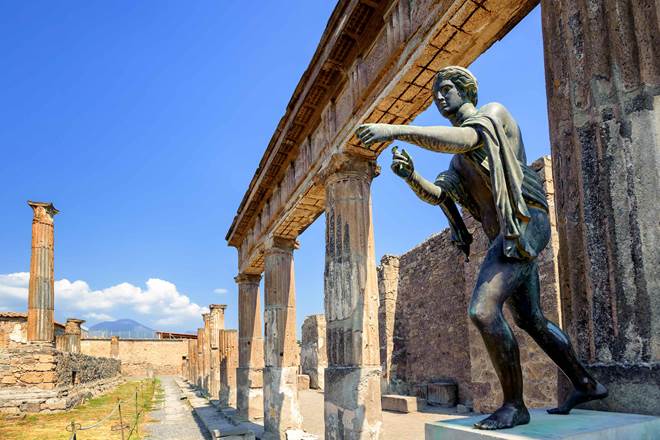1. Villa dei Misteri
Take the train operated by Trenitalia from Napoli San Giovanni Barra to Pompeii and you’ll reach your destination in about half an hour. Don't miss out on one of the best things to see in Pompeii, Villa dei Misteri ('Villa of the Mysteries'), on your way to the excavation site, as it boasts some of the finest frescoes in all of Italy.
2. Forum, basilica and granary
Your next stop is the forum, which was the heart and centre of Roman public life. Here political issues were discussed and goods were bought and sold. It was in the basilica that these decisions were actually carried out. Today the granary gives archaeologists, and us, insight into what kind of everyday goods were traded on the forum market and consumed by people just like us.
3. Amphitheatre
Situated in the east corner of Pompeii and close to the Sarno Gate entrance, this is one of the best preserved and most visited Roman amphitheatres in the world. It dates from the 1st century BC and had space for up to 20,000 people. Imagine the fierce gladiators' battles that once transpired here. Nowadays used occasionally for concerts and other events, in 1971 it was the band Pink Floyd who performed in the amphitheatre, marking the first time a large event took place here in nearly 2,000 years.
4. Great Gymnasium
Opposite the Amphitheatre was a huge sports field surrounded by colonnades where many sports activities took place. In Roman times it even had a pool. The gymnasium also included a palaestra, a Greek-style wrestling school, where young men were trained in this hugely popular sport. Gymnasia and palaestra were originally a Greek invention, but like many other things they were eagerly adopted, and improved upon, by the Romans.
5. House of the Vettii
If you love Greek mythology and frescoes, make sure you stop at the House of the Vettii. This building is full of well-preserved frescoes that show mainly mythological scenes, some of them rather suggestive, if not outright explicit. In the entrance you’re greeted by a fresco of the well-endowed fertility god Priapus, and further into the house there is a similar one set in marble. Between the two you can admire twelve tamer, mythological scenes like baby Hercules strangling the snakes.
6. Temple of Apollo
Far more sedate and spiritual is the Temple of Apollo, or better said its remains. It’s one of the most ancient buildings in Pompeii and some Etruscan remains date back to the 6th century BC. The ruins exude a special ancient aura, many columns are still intact and you can perfectly see the layout of what was once the most important temple in town. If you stand before it, you can see, and photograph, Mount Vesuvius in the background.
7. House of the Faun
Built at the time when Greek and Italian architectural styles merged, this was one of the largest private residences in the town. It’s famous for its resplendent mosaics, like the one that depicts the battle between Alexander the Great and Darius III of Persia. Some historians consider it a better example of sophisticated living at the time of the Roman Empire than the buildings in Rome itself.
8. Roman Baths
There's no doubt, the Romans made bathing popular in the ancient world! Pompeii had several baths. The best-preserved ones are those at the north end of the forum. Take care not to miss them, as they’re not very well sign-posted. Also, visit the Stabian baths if you want to learn more about how they functioned and how they were used by the citizens.
9. House of Menander
Discover the well-preserved House of Menander and take in the beauty of the Greek architecture. Corinthian capitals embellish the entrance, suggesting that the house belonged to a rich merchant. Step inside the atrium and admire the interior rooms, which are decorated with scenes from Homer’s Iliad – you may even recognise some of its main characters!
10. Other interesting facts about Pompeii
Did you know that the oldest and well-known “Beware of the dog” sign was found here in Pompeii? Only they wrote it in Latin. Look out in the atrium of the charming little House of the Tragic Poet if you can spot the words Cave Canem somewhere.
Embedded in many street surfaces, and still visible today, are reflective tiles called “cats’ eyes”. Like real feline eyes, they reflected the light of torches, candles and even moonlight, providing rudimentary illumination for the people of Pompeii out on a late-night stroll. You might also notice large, round holes in the ground in some areas. In times past, these were containers with ready-to-eat street food, basically fast-food on Roman terms. A far more sombre place is the Garden of the Fugitives, where plaster casts of thirteen ancient victims of a volcano eruption are displayed in the way they were found in the ashes.
A day trip from Naples to Pompeii is a great way to immerse yourself in Greek and Roman history. Make sure you're well prepared for your day trip and take sun protection, water and food with you. If you don't want to bring your own provisions, the panini and fresh juices sold at many stalls on the way to the excavation site are a good alternative.
Are you in Rome and want to go on a day trip to Pompeii? Take a Frecciarossa high-speed train to Naples and complete the last leg of your journey on a regional train operated by Trenitalia. On Frecciarossa trains you'll get the chance to enjoy the high-quality onboard services, including large leather seats, at-seat power sockets, free WiFi, onboard entertainment Le Frecce Portal and a welcome service with complimentary drinks and snacks in all classes except for the Standard one. Read Our complete guide to the best day trip from Rome to Pompeii for more information and get ready for your next adventure!

